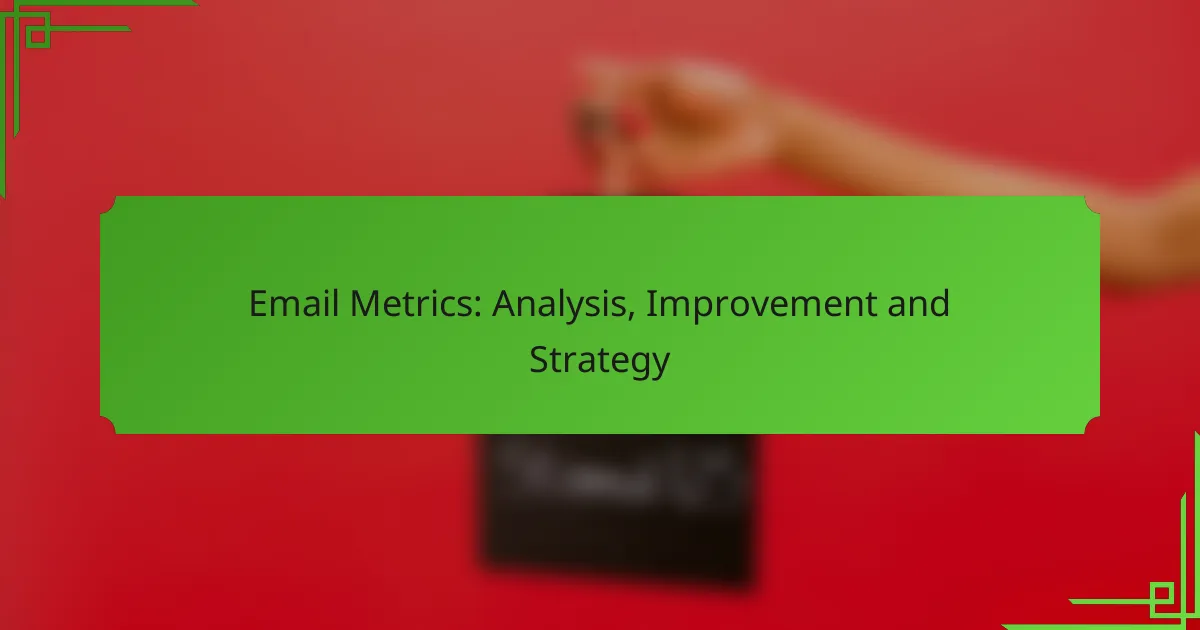Email metrics play a vital role in assessing the effectiveness of your campaigns and guiding improvements. By analyzing key indicators such as open rates, click-through rates, and conversion rates, you can gain valuable insights into recipient engagement and optimize your strategies accordingly. Focusing on elements like subject lines, timing, and audience segmentation can significantly enhance your email performance.

How can I improve email open rates?
Improving email open rates involves optimizing various elements of your email campaigns to capture recipients’ attention. Focus on crafting compelling subject lines, sending at the right times, and segmenting your audience effectively.
Personalized subject lines
Personalized subject lines can significantly increase open rates by making emails feel more relevant to the recipient. Use the recipient’s name or tailor the subject to their interests or past behaviors. For example, “John, check out your exclusive offer!” is more engaging than a generic subject.
Avoid overly promotional language in personalized subject lines, as this can trigger spam filters. Instead, aim for a conversational tone that invites the reader to open the email.
Optimal send times
Sending emails at optimal times can enhance open rates by ensuring your message arrives when recipients are most likely to check their inbox. Research suggests that mid-morning and early afternoon on weekdays are often effective, but this can vary by audience.
Consider using analytics tools to determine when your specific audience is most active. Testing different send times can help you identify patterns that work best for your subscribers.
Segmented email lists
Segmenting your email lists allows you to tailor content to specific groups based on demographics, purchase history, or engagement levels. This targeted approach can lead to higher open rates as recipients receive content that resonates with them.
For instance, sending a special promotion to frequent buyers can be more effective than a blanket email to your entire list. Regularly update your segments as subscriber behaviors change.
A/B testing strategies
A/B testing involves sending two variations of an email to different segments of your audience to see which performs better. You can test subject lines, send times, or content formats to gather data on what drives higher open rates.
Make sure to test one variable at a time to accurately assess the impact of each change. Analyze the results and apply the winning strategies to future campaigns for continuous improvement.
Engaging preview text
Preview text, the snippet that appears next to or below the subject line in an inbox, plays a crucial role in enticing recipients to open your email. Use this space to complement your subject line with additional context or a compelling call to action.
Keep it concise and relevant, ideally under 100 characters, and ensure it aligns with the overall message of your email. Avoid repeating the subject line; instead, provide new information that piques interest.

What metrics should I track for email campaigns?
Tracking the right metrics for email campaigns is crucial for understanding performance and optimizing future efforts. Key metrics include open rate, click-through rate, conversion rate, unsubscribe rate, and bounce rate, each providing insights into different aspects of your email effectiveness.
Open rate
The open rate measures the percentage of recipients who open your email compared to the total number of emails sent. A good open rate typically falls between 15% and 25%, but this can vary by industry. To improve your open rate, focus on crafting compelling subject lines and segmenting your audience effectively.
Consider A/B testing different subject lines to see which ones resonate best with your audience. Avoid using spammy words that could trigger filters and prevent your emails from reaching inboxes.
Click-through rate
The click-through rate (CTR) indicates the percentage of recipients who clicked on one or more links within your email. A healthy CTR usually ranges from 2% to 5%, depending on your industry and audience engagement. To enhance your CTR, ensure that your calls to action (CTAs) are clear and enticing.
Utilize buttons instead of text links for CTAs, as they tend to attract more clicks. Additionally, placing links strategically within the email can guide readers toward desired actions effectively.
Conversion rate
The conversion rate reflects the percentage of recipients who complete a desired action after clicking through your email, such as making a purchase or signing up for a webinar. This metric is vital for measuring the overall success of your email campaigns. A typical conversion rate might range from 1% to 5%.
To boost conversion rates, ensure that the landing page aligns with the email content and provides a seamless user experience. Personalization can also enhance conversions by making offers more relevant to individual recipients.
Unsubscribe rate
The unsubscribe rate shows the percentage of recipients who opt out of your mailing list after receiving an email. A low unsubscribe rate, generally below 1%, indicates that your content is resonating well with your audience. High unsubscribe rates may signal that your emails are not meeting subscriber expectations.
To reduce unsubscribe rates, regularly review your email frequency and content relevance. Providing options for subscribers to customize their preferences can also help retain audience interest.
Bounce rate
The bounce rate indicates the percentage of emails that were not successfully delivered to recipients’ inboxes. A bounce rate below 2% is considered acceptable, while higher rates may require attention. Bounces can be categorized as hard (permanent issues) or soft (temporary issues), and understanding the difference is key to maintaining a healthy list.
To manage bounce rates, regularly clean your email list by removing invalid addresses and ensuring that your sign-up forms are optimized to capture accurate information. Monitoring bounce rates helps maintain sender reputation and improves overall deliverability.

How do I analyze email performance?
To analyze email performance, focus on key metrics such as open rates, click-through rates, and conversion rates. These indicators help you understand how well your emails engage recipients and drive desired actions.
Using analytics tools
Analytics tools like Google Analytics, Mailchimp, or HubSpot provide valuable insights into email performance. They track metrics such as open rates, click rates, and bounce rates, allowing you to assess the effectiveness of your campaigns.
When using these tools, ensure you set up proper tracking parameters to measure specific actions, such as purchases or sign-ups, resulting from your emails. This will help you connect email performance directly to business outcomes.
Benchmarking against industry standards
Benchmarking involves comparing your email metrics to industry averages to gauge performance. For instance, average open rates typically range from 15% to 25%, while click-through rates can vary from 2% to 5% depending on the sector.
Use these benchmarks to identify areas for improvement. If your open rates are significantly below average, consider optimizing your subject lines or sending times to enhance engagement.
Identifying trends over time
Tracking email performance over time helps you identify trends and patterns in recipient behavior. Regularly review metrics on a monthly or quarterly basis to spot improvements or declines in engagement.
For example, if you notice a consistent increase in click-through rates after implementing personalized content, this trend indicates that your audience responds positively to tailored messaging. Adjust your strategies accordingly to capitalize on these insights.

What are the best practices for email content?
Best practices for email content focus on clarity, engagement, and responsiveness. Effective emails should capture attention quickly, provide valuable information, and encourage action from the reader.
Clear call-to-action
A clear call-to-action (CTA) is essential for guiding recipients toward the desired outcome, whether it’s making a purchase, signing up for a newsletter, or downloading a resource. Use concise and action-oriented language, such as “Shop Now” or “Get Your Free Trial.”
Position your CTA prominently within the email, ideally above the fold, to ensure it’s easily visible. Consider using contrasting colors and buttons to make the CTA stand out, increasing the likelihood of engagement.
Mobile-friendly design
With a significant portion of emails being opened on mobile devices, a mobile-friendly design is crucial. Ensure your email template is responsive, meaning it adjusts seamlessly to different screen sizes, providing an optimal reading experience.
Keep your layout simple, using larger fonts and buttons that are easy to tap. Limit the use of images and ensure they are optimized for quick loading. Testing your emails on various devices can help identify any issues before sending.
